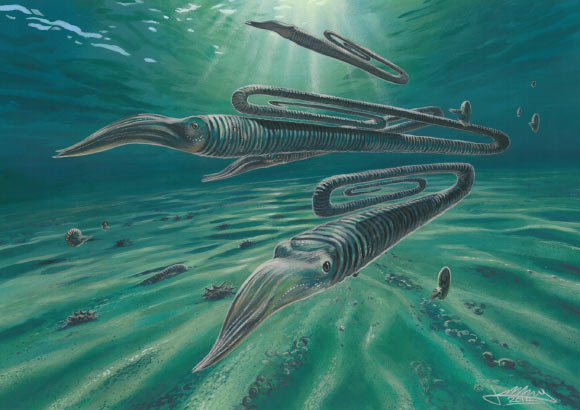The end-Cretaceous mass extinction event, also known as the K/T extinction — the event that wiped out the dinosaurs as well as nearly 50% of all the world’s species — was rapid and just as deadly to marine life in what is now Antarctica, according to new research.

Reconstruction of typical Cretaceous marine environment in Antarctica, including the paperclip-shaped ammonite Diplomoceras. Image credit: James McKay.
“We show that the extinction was rapid and severe in Antarctica, with no significant biotic decline during the latest Cretaceous, contrary to previous studies,” the study authors said.
“These data are consistent with a catastrophic driver for the extinction, such as bolide impact, rather than a significant contribution from Deccan Traps volcanism during the late Maastrichtian.”
The research, published in the May 26 issue of the journal Nature Communications, involved a long-term process of identifying more than 6,000 marine fossils ranging in age from 69- to 65-million-years-old.
This enormous collection, excavated by paleontologists on Seymour Island in the Antarctic Peninsula, includes a wide range of species — from small snails and clams that lived on the sea floor to large and unusual creatures that swam in the surface waters of the ocean.
These include Diplomoceras, an ammonite with a paperclip-shaped shell that could grow as large as 2 m, and massive marine reptiles such as Mosasaurus.
“Antarctic rocks contain a truly exceptional assemblage of fossils that have yielded new and surprising information about the evolution of life 66 million years ago,” said co-author Prof. Jane Francis, from the British Antarctic Survey.
“Even the animals that lived at the ends of the Earth close to the South Pole were not safe from the devastating effects of the mass extinction at the end of the Cretaceous period.”
With the fossils grouped by age, the collection shows a dramatic 65-70% reduction in the number of species living in the Antarctic 66 million years ago — coinciding exactly with the time when the dinosaurs and many other groups of organisms worldwide became extinct at the end of the Cretaceous.
Previously, paleontologists had thought that creatures living near the Poles were far enough away from the cause of the end-Cretaceous extinction to be badly affected — whether this was an asteroid impact in the Gulf of Mexico, where a giant buried impact crater is found today, or extreme volcanism in the Deccan volcanic province in India.
_____
James D. Witts et al. 2016. Macrofossil evidence for a rapid and severe Cretaceous–Paleogene mass extinction in Antarctica. Nature Communications 7, article number: 11738; doi: 10.1038/ncomms11738







